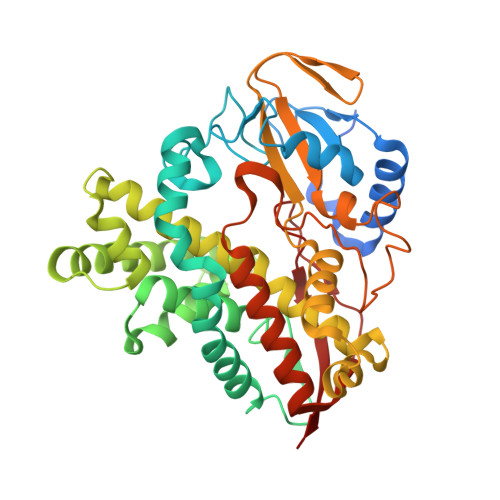Structural characterization of oxyd, a cytochrome p450 involved in {beta}-hydroxytyrosine formation in vancomycin biosynthesis
Cryle, M.J., Meinhart, A., Schlichting, I.(2010) J Biol Chem 285: 24562-24574
- PubMed: 20519494
- DOI: https://doi.org/10.1074/jbc.M110.131904
- Primary Citation of Related Structures:
3MGX - PubMed Abstract:
The cytochrome P450 OxyD from the balhimycin glycopeptide antibiotic biosynthetic operon of Amycolatopsis mediterranei is involved in the biosynthesis of the modified amino acid beta-R-hydroxytyrosine, an essential precursor for biosynthesis of the vancomycin-type aglycone. OxyD binds the substrate tyrosine not free in solution, but rather covalently linked to the carrier protein (CP) domain of the non-ribosomal peptide synthase BpsD, exhibiting micromolar binding affinity to a tyrosine-loaded carrier protein construct. The crystal structure of OxyD was determined to 2.1-A resolution, revealing a potential binding site for the carrier protein-bound substrate in a different orientation to that seen with the acyl carrier protein-bound P450(BioI) (Cryle, M. J., and Schlichting, I. (2008) Proc. Natl. Acad. Sci. U.S.A. 105, 15696-15701). A series of residues were identified across known aminoacyl-CP-oxidizing P450s that are highly conserved and cluster in the active site or potential CP binding site of OxyD. These residues appear to be characteristic for aminoacyl-CP-oxidizing P450s, allowing sequence based identification of P450 function for this subgroup of P450s that play vital roles in the biosyntheses of many important natural products in addition to the vancomycin-type antibiotics. The ability to analyze such P450 function based upon sequence data alone should prove an important tool in the analysis and identification of new medicinally relevant biomolecules.
Organizational Affiliation:
Department of Biomolecular Mechanisms, Max-Planck Institute for Medical Research, Jahnstrasse 29, 69120 Heidelberg, Germany. Max.Cryle@mpimf-heidelberg.mpg.de
















